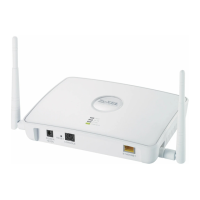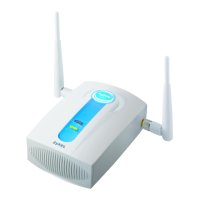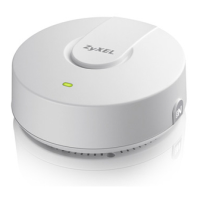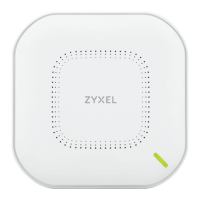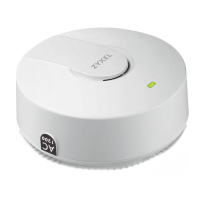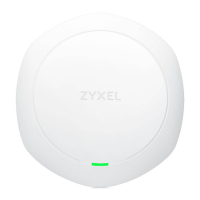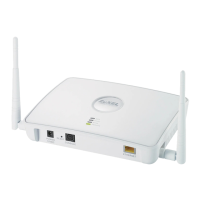
Do you have a question about the ZyXEL Communications NWA-3160 and is the answer not in the manual?
| power supply | 12 V DC, 1.5 A |
|---|---|
| power over ethernet | Yes |
| operating temperature | 0°C ~ 50°C |
|---|---|
| operating humidity | 20% ~ 95% (non-condensing) |
| storage temperature | -30°C ~ 60°C |
| storage humidity | 20% ~ 95% |
| frequency band USA | 2.412 to 2.462 GHz; 5.15 to 5.25 GHz, 5.470 to 5.725 GHz, 5.725 to 5.825 GHz |
|---|---|
| frequency band ETSI | 2.412 to 2.472 GHz; 5.15 to 5.35 GHz, 5.470 to 5.725 GHz |
| frequency band Taiwan | 2.412 to 2.462 GHz; 5.25 to 5.35 GHz, 5.725 to 5.825 GHz |
| coverage range indoor 11g | up to 100 m |
| coverage range outdoor 11g | up to 400 m |
| coverage range indoor 11a | up to 80 m |
| coverage range outdoor 11a | up to 200 m |
| wired data rates | 10/100 Mbps Auto-sensing |
|---|---|
| wireless data rates IEEE 802.11b | CCK: 11/5.5 Mbps, DQPSK: 2 Mbps, DBPSK: 1 Mbps |
| wireless data rates IEEE 802.11g | QAM64: 54/48 Mbps, QAM16: 36/24 Mbps, QPSK: 18/12 Mbps, BPSK: 9/6 Mbps |
| weight | 420 g |
|---|---|
| dimensions | 138.5 (W) x 198.5 (D) x 47.5 (H) mm |
Covers essential safety guidelines for device usage, environment, and handling to prevent harm.
Introduces the NWA series, its capabilities, and benefits for extending wired networks wirelessly.
Details the steps required to access the NWA's web-based configuration interface.
Explains how to reset the NWA to factory defaults, including methods and consequences.
Guides users on choosing wireless operating modes and setting up the wireless LAN.
Explains configuring and using the rogue AP detection feature to enhance network security.
Details how to use MAC filters and layer-2 isolation for user access control to network resources.
Guides on configuring the NWA's controller AP and managed AP modes for centralized network management.
Describes how to get a quick view of system, Ethernet, and WLAN information on the NWA.
Details the screen used to configure the NWA as a CAPWAP managed AP or in its default standalone mode.
Explains the Status screen in AP controller mode, detailing system and AP status information.
Controls access to the NWA by assigning a password and configuring RADIUS authentication.
Explains how to choose the NWA's operating mode: AP, AP+Bridge, Bridge/Repeater, or MBSSID.
Covers selecting and configuring SSID profiles, referencing Security, RADIUS, and MAC Filter settings.
Details how to configure an SSID profile, including hiding SSID and setting QoS parameters.
Covers choosing and editing security profiles like WEP, 802.1x, WPA, and WPA2.
Details how to set up RADIUS server settings, including primary and backup server configurations.
Covers selecting and configuring layer-2 isolation profiles to control client access to specific devices.
Explains MAC filter profiles and how each can reference a list of MAC addresses for filtering.
Details how to configure MAC filter settings, defining actions like Allow or Deny Association.
Covers configuring the IP address, subnet mask, and gateway IP address for the NWA.
Explains rogue APs and their security threat, introducing detection and location methods.
Details enabling Rogue AP detection settings, including period, expiration, and friendly AP list management.
Covers specifying trusted APs by adding them to the friendly AP list.
Displays details of all wireless access points within coverage, except those in the friendly AP list.
Details turning the NWA's internal RADIUS server on/off and viewing certificate information.
Allows viewing certificates, managing storage space, and importing or creating new certificates.
Allows displaying logs for specific categories or all logs, including alerts and sorting options.
Configures where and when logs are sent, specifying log categories and email alert settings.
Enables and configures Wireless Virtual LAN setup, mapping SSIDs to VLAN IDs for traffic tagging.
Details configuring load balancing by station number or traffic level for network integrity.
Details configuring Dynamic Channel Selection options, including sensitivity and client awareness.
Provides a quick summary of the NWA's status, including firmware version and IP address.
Guides on uploading new firmware to the NWA using the F/W Upload screen.
Enables backup, upload, and resetting of the NWA's configuration file to factory defaults.
Addresses issues related to the device not powering on or LEDs behaving unexpectedly.
Provides solutions for forgetting the IP address or password, or accessing the login screen.
Helps resolve issues with accessing the Internet, including connection failures and slow performance.
Addresses problems with accessing the NWA or pinging computers from the WLAN.
Guides on obtaining and configuring IP addresses, including static and dynamic assignments.
Introduces the command line interface (CLI) and methods to access it via Console Port or Telnet.
Provides instructions for logging into the NWA using administrator credentials.
